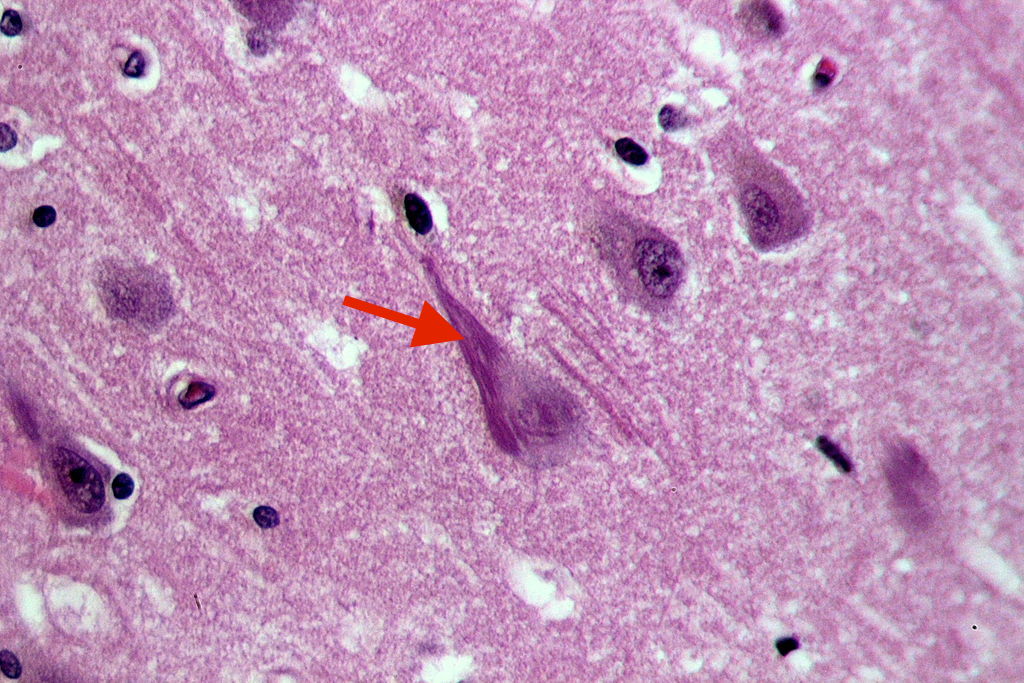WBR0155: Difference between revisions
Jump to navigation
Jump to search
No edit summary |
No edit summary |
||
| Line 23: | Line 23: | ||
|Prompt=A 37-year-old man with Down syndrome is brought to the family's physician for cognitive decline. The family reports that the patient’s memory has been deteriorating for the last year. He cannot recall the names of his brothers and sisters and often has difficulty finding words. He is unable to find his way back home and gets lost when a member of his family does not assist him. The presence of which of the following neuropathologic changes is most likely in this patient? | |Prompt=A 37-year-old man with Down syndrome is brought to the family's physician for cognitive decline. The family reports that the patient’s memory has been deteriorating for the last year. He cannot recall the names of his brothers and sisters and often has difficulty finding words. He is unable to find his way back home and gets lost when a member of his family does not assist him. The presence of which of the following neuropathologic changes is most likely in this patient? | ||
|Explanation=Patient’s with [[Down syndrome]] have a high risk of developing [[Alzheimer’s]] disease at an early age, and this patient's symptoms are highly consistent with the disease. Neurofibrillary tangles are pathological protein aggregates found within neurons in cases of Alzheimer's disease. Tangles are formed by hyperphosphorylation of a microtubule-associated protein called tau, causing it to aggregate in an insoluble form. | |Explanation=Patient’s with [[Down syndrome]] have a high risk of developing [[Alzheimer’s]] disease at an early age, and this patient's symptoms are highly consistent with the disease. Neurofibrillary tangles are pathological protein aggregates found within neurons in cases of Alzheimer's disease. Tangles are formed by hyperphosphorylation of a microtubule-associated protein called tau, causing it to aggregate in an insoluble form. | ||
[[File:NFT_9_2_14.JPG |400px | [[File:NFT_9_2_14.JPG |400px| alt = Neurofibrillary tangle in the hippocampus of AD patient |Neurofibrillary tangle (red arrow)]] | ||
|AnswerA=Neurofibrillary tangles | |AnswerA=Neurofibrillary tangles | ||
|AnswerAExp=Neurofibrillary tangles are pathological protein aggregates found within neurons in cases of Alzheimer's disease. Patient’s with Down syndrome have a high risk of developing Alzheimer’s disease at an early age due to increased gene dosage of the amyloid precursor protein (APP) on chromosome 21. | |AnswerAExp=Neurofibrillary tangles are pathological protein aggregates found within neurons in cases of Alzheimer's disease. Patient’s with Down syndrome have a high risk of developing Alzheimer’s disease at an early age due to increased gene dosage of the amyloid precursor protein (APP) on chromosome 21. | ||
Revision as of 01:51, 3 September 2014
| Author | [[PageAuthor::Rim Halaby, M.D. [1] (Reviewed by William J Gibson)]] |
|---|---|
| Exam Type | ExamType::USMLE Step 1 |
| Main Category | MainCategory::Pathology |
| Sub Category | SubCategory::Neurology |
| Prompt | [[Prompt::A 37-year-old man with Down syndrome is brought to the family's physician for cognitive decline. The family reports that the patient’s memory has been deteriorating for the last year. He cannot recall the names of his brothers and sisters and often has difficulty finding words. He is unable to find his way back home and gets lost when a member of his family does not assist him. The presence of which of the following neuropathologic changes is most likely in this patient?]] |
| Answer A | AnswerA::Neurofibrillary tangles |
| Answer A Explanation | [[AnswerAExp::Neurofibrillary tangles are pathological protein aggregates found within neurons in cases of Alzheimer's disease. Patient’s with Down syndrome have a high risk of developing Alzheimer’s disease at an early age due to increased gene dosage of the amyloid precursor protein (APP) on chromosome 21.]] |
| Answer B | AnswerB::Pick bodies |
| Answer B Explanation | [[AnswerBExp::Pick bodies are silver-staining, spherical aggregations of tau protein in neurons associated with Pick's disease, a subtype of frontotemporal lobar degeneration. While Pick’s disease is characterized by memory loss, it is distinguished from Alzheimer's disease by often severe mood and personality change.]] |
| Answer C | AnswerC::Negri bodies |
| Answer C Explanation | [[AnswerCExp::Negri bodies are eosinophilic, sharply outlined, pathognomonic inclusion bodies (2–10 µm in diameter) found in the cytoplasm of certain nerve cells containing rabies virus. Rabies causes acute encephalitis, and it is generally preceded by an animal bite.]] |
| Answer D | AnswerD::Lewy bodies |
| Answer D Explanation | [[AnswerDExp::Lewy bodies are abnormal aggregates of protein (alpha-synuclein) that develop inside nerve cells. The most common disease associated with the presence of Lewy bodies is Parkinson's disease. Lewy bodies are also present in neurons in dementia with Lewy bodies and the Lewy body variant of Alzheimer's disease.]] |
| Answer E | AnswerE::Spongioform changes |
| Answer E Explanation | [[AnswerEExp::Spongiform change in the gray matter is the pathologic hallmark of Creutzfold Jacob disease. It is characterized by the presence of many round vacuoles in all six cortical layers of the cerebral cortex, giving the brain a "spongy" appearance. These vacuoles appear glassy or eosinophilic and may coalesce. Neuronal loss and gliosis are also seen in CJD.]] |
| Right Answer | RightAnswer::A |
| Explanation | [[Explanation::Patient’s with Down syndrome have a high risk of developing Alzheimer’s disease at an early age, and this patient's symptoms are highly consistent with the disease. Neurofibrillary tangles are pathological protein aggregates found within neurons in cases of Alzheimer's disease. Tangles are formed by hyperphosphorylation of a microtubule-associated protein called tau, causing it to aggregate in an insoluble form.
Glenner GG, Wong CW. Alzheimer's disease and Down's syndrome: sharing of a unique cerebrovascular amyloid fibril protein. Biochem Biophys Res Commun. 1984;122(3):1131-5.]] |
| Approved | Approved::Yes |
| Keyword | WBRKeyword::Down syndrome, WBRKeyword::Mental retardation, WBRKeyword::Retardation, WBRKeyword::Intellectual disability, WBRKeyword::Neurodegeneration, WBRKeyword::Alzheimer's disease, WBRKeyword::Alzheimer, WBRKeyword::Dementia, WBRKeyword::Alzheimer disease, WBRKeyword::Cognitive, WBRKeyword::Cognitive decline, WBRKeyword::Neuropathology, WBRKeyword::Brain, WBRKeyword::Neurofibrillary tangles, WBRKeyword::Chromosome, WBRKeyword::Memory, WBRKeyword::Memory loss |
| Linked Question | Linked:: |
| Order in Linked Questions | LinkedOrder:: |
